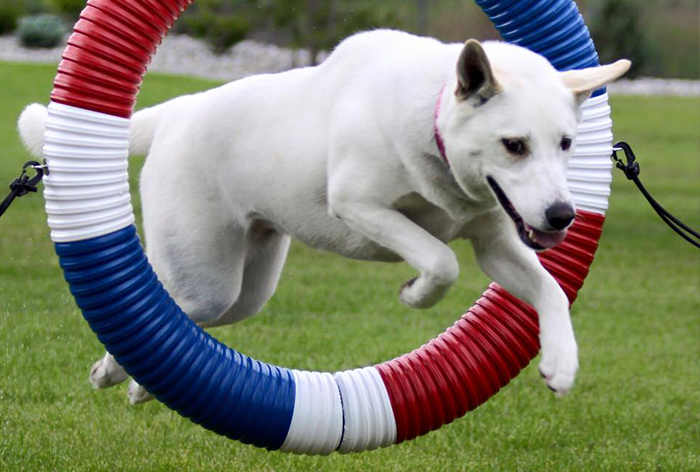Dog agility: it takes two
Posted on July 7, 2016 at 6:00 am
By Jane Baker
Previously I’ve written about my crazy, hyper dog, Yuki, and the things I’ve discovered while looking for activities that include canine companions. I’ve seen the fast-paced agility courses on TV and am mesmerized by those dogs flying through a course of obstacles. Yuki and I have had basic obedience down for a while, and we’re already a little bored with shaking “hands” and playing dead. So I signed up for a small beginning agility class at a local boarding facility, the K9 Country Club.
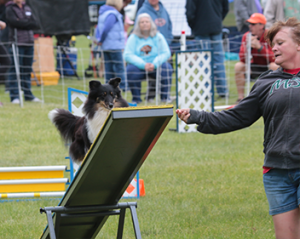
Beginning Agility, taught by dog handler and breeder Joanne Hamacher, started with basics of circling Yuki right, then left, and sending her to a target. We had homework to practice nearly every day. I searched the internet for building my own agility course. Joanne’s 20 years of experience in agility helped Yuki overcome a brief fear of heights on the dog walk and grew my appreciation for the amazing animal we call dog.
In England in the late 70s, agility started as a filler act at a dog show. Designed to keep crowds entertained between the judged events, dog agility is based on horse show competitions. It quickly grew and spread globally with guidelines established by organizations like the American Kennel Club (AKC) and the United States Dog Agility Association (USDAA). It’s considered a team sport, with the team being the handler and dog. Together the team must maneuver a course of obstacles in the fastest time possible.
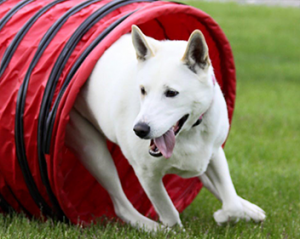
If you enjoy interacting with your dog, agility is not only good exercise for both dog and human, but its great fun for both. For the dog, agility exercises both mind and body as they are thinking through cues from the handler and running as fast as possible. For handler, it’s keeping one step ahead of a speeding dog and staying out of her way! Our beginning agility classes grew into intermediate and then more advanced as the course grew to 10 obstacles. In a little over a year, Yuki went from learning her left from her right to racing through the course at a pace that leaves me literally and figuratively, breathless.
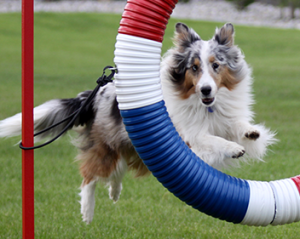
Any breed of dog can do agility. Joanne breeds and competes with Shetland Sheepdogs. “I started with Border Collies, and they are the most popular, but as long as they are structurally sound any breed can do it,” she says. Also depending on the dog, you can start them at any age, but of course, the younger they are the easier they are to train, both dog and handler. In her experience, Joanne shared that “the old saying that you can’t teach an old dog new tricks is not true.”
Joanne would often bring her dog, Stitch, to class. Together, Joanne and Stitch would demonstrate whatever we were learning that day. Stitch would fly through the obstacles, as light as a feather and seemingly without effort. In contrast, Yuki, my Husky-mix standing twice as tall as Stitch, barrels through the course like a horse on stampede. Both dogs finish as if they’ve just been on the best amusement ride ever. For handlers, it’s a thrill to communicate the course’s path to the dog and see the dog run it perfectly.
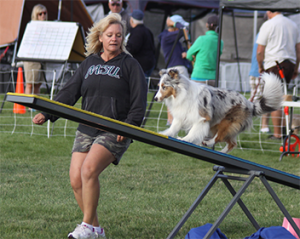
There are many reasons why people do agility with their dogs. When asked, Joanne says she does it because she loves dogs, teamwork, and competition. I was drawn to agility for something fun to do, but I continue to do it for the exercise and pure enjoyment of working with my dog.
Agility is more about the bond between dog and handler than it is about teaching a dog to do tricks. If anything, the agility class is more about training the handler. Dogs understand a human’s intention; the human has to communicate that intention to the dog by staying one or two steps ahead—human interpreting dog and dog interpreting human, all at breakneck speed—whew!
Another reason people participate in agility is the social aspect. As with any organized competition, you are doing something with like-minded people. You can travel around and do agility trials every weekend if you get bitten by the agility bug. Winners receive ribbons—there is no prize purse. You won’t get financially rich competing in dog agility, but you’ll be rewarded in other ways. There is a big agility community in Spokane with locally held trials with 350 or more runs per day.
To get into agility, find a club or person to train with, or go watch a competition. Once you watch, you’ll want to do it. The Spokane Dog Training Club is hosting trials on July 9 and 10. The public is welcome, and it’s free to watch. You’ll see trials where a dog has to do the course perfectly and under time. At every trial there is a new course, the judges create them, and each is AKC approved. However, the course is unknown to the teams until the morning of the trials.
Want to learn more? Check the AKC website or locally with the Spokane Dog Training Club or Lilac City Dog Training. You can also do an internet search for “dog agility Spokane” to find lots of resources. Also, you can read books about agility at the Spokane County Library District.
At the time of this writing, I have registered for an agility class at the Spokane Dog Training Club, but classes haven’t started yet. I’ll share more about the new class in the comments in a few weeks to let you know how it’s going. If you’re part of the dog agility community in Spokane, please share why you do agility (or flyball, rally, etc.) in the comments.
Tags: agility, agility course building, dog, dog training

